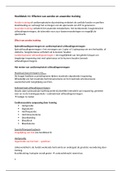Article Summaries
UEC31306 – Human decision making
Wageningen university
2021
The following articles are summarized in this document
Achar, C., So, J., Agrawal, N., & Duhachek, A. (2016). What we feel and why we buy: The influence of
emotions on consumer decision-making. Current Opinion in Psychology, 10, 166–170.
https://doi.org/10.1016/j.copsyc.2016.01.009
Furnham, A., & Boo, H. C. (2011). A literature review of the anchoring effect. The Journal of Socio-
Economics, 40, 35–42. https://doi.org/10.1016/j.socec.2010.10.008
Inzlicht, M., & Friese, M. (2019). The past, present, and future of ego depletion. Social Psychology,
50, 370–378. https://doi.org/10.1027/1864-9335/a000398
Mussweiler, T., Strack, F., & Pfeiffer, T. (2000). Overcoming the inevitable anchoring effect:
Considering the opposite compensates for selective accessibility. Personality and Social Psychology
Bulletin, 26, 1142–1150.
Pham, M. T. (2014). Feels right... Go ahead? When to trust your feelings in judgments and decisions.
GfK Marketing Intelligence Review, 6, 22–27.
Read, D., & van Leeuwen, B. (1998). Predicting hunger: The effects of appetite and delay on choice.
Organizational Behavior and Human Decision Processes, 76, 189–205.
https://doi.org/10.1006/obhd.1998.2803
Schwartz, B., Ward, A., Monterosso, J., Lyubomirsky, S., White, K., & Lehman, D. R. (2002).
Maximizing versus satisficing: Happiness is a matter of choice. Journal of Personality and Social
Psychology, 83, 1178–1197
Shalvi, S., Dana, J., Handgraaf, M. J. J., & de Dreu, C. K. W. (2011). Justified ethicality: Observing
desired counterfactuals modifies ethical perceptions and behavior. Organizational Behavior and
Human Decision Processes, 115, 181–190. https://doi.org/10.1016/j.obhdp.2011.02.001
Schulz-Hardt, S., Frey, D., Lüthgens, C., & Moscovici, S. (2000). Biased information search in
group decision making. Journal of Personality and Social Psychology, 78, 655–669.
Isenberg, D. J. (1986). Group polarization: A critical review and meta-analysis. Journal of
Personality and Social Psychology, 50, 1141–1151
Handgraaf, M. J. J., Griffioen, A. M., Bolderdijk, J. W., & Thøgersen, J. (2018). Economic
psychology and pro‐environmental behaviour. In R. Ranyard (Ed.), Economic Psychology
(435–450).
, What we feel and why we buy: The influence of emotions on
consumer decision-making
Emotions are multidimensional feelings that reflect information about consumers’ relationships to
their social and physical surroundings as well as their interpretations regarding these relationships.
Each emotion is associated with an appraisal, aka cognitive evaluation.
Emotional influences are categorized based on their relationship with decisions. Appraisals
associated with emotions influence judgement. Integral emotions are emotions embedded in
marketing stimuli meaning to influence a decision via cognitive appraisals. Incidental emotions arise
from unrelated sources, but their influence carries over to a decision. Integral and incidental
emotions can interact as well as contrast each other.
Integral emotions
Brands and marketing messages systematically portray and evoke emotions that encourage desired
consumer responses.
How?
Consumer’s reaction to emotional appeal is because one modifies their self-concept relative to
others; because the motivation to comply with an appeal is increased through emotions; and
because of contagion effects, coping effects that are seen.
Framing in the appeal by emotions influences consumers as well. High fear arousing appeals are
defensively processed, and meta-cognitive fluency enhances effectiveness of emotional appeals.
When?
Effectiveness of emotional appeal depends on many factors, especially on culture. Emotional appeals
that are not compatible with their culture may be more effective due to their novelty. Also,
emotional appeals increase effectiveness when they are salient with someone’s self-identity.
Summary: emotional appeals skew one’s thinking to appraisals associated with emotions.
Incidental emotions
Incidental emotions can affect a variety of consumer response
How?
Incidental emotions influence unrelated decisions via processes such as enhancing message
compatibility, changing temporal focus and mindsets.
For example, guilt arises from behavior-specific appraisal. Which leads to consumer valuing
secondary features of a product. Shame arises from global self-appraisal, and lead to valuing primary
feature. Future based appraisals (like hope) lead to healthier choices, compared with present and
past focus (like pride).
When?
The occurrence of incidental emotions depends on the source of the emotions, the presence of
goals, or physical proximity.







